Contents
- Introduction
- Aims
- Objectives
- Area of study
- Consultation process
- Policy context
- Delivery and Governance of Existing Lighting Infrastructure
- Case studies
- Lighting pilots projects
- Analysis
- Considerations
- Quality
- Lighting design guidance
- Conclusion
Introduction
Belfast is an ambitious international city with a thriving business sector, a rich and eclectic cultural community and arts programme, a diverse built environment and a growing number of visitor attractions. As Belfast continues to develop and grow, the importance of creating a liveable city, with genuine shared space and environments that support and encourage people to live well together is critical. The potential of light to contribute to the creation and transformation of such environments, in both tangible and intangible ways, is well documented.
The Italian writer and philosopher Italo Calvino talked much about subtracting weight, sometimes from people, sometimes from celestial bodies and sometimes from cities.
The concept of removing weight from a city could translate into many of today’s ‘placemaking’ methodologies. Our efforts to reduce clutter, to rationalise and make uniform multiple and competing elements in the urban landscape to limit visual noise, is to address the opacity of the city, making it more permeable, more pleasing, ‘lighter’.
Contributing to the balancing of lightness and heaviness in a city, is the balancing of lightness and darkness.
Thoughtfully designed lighting positively contributes to, and even creates ‘places’. Precinct lighting in Belfast has predominantly been delivered through various departments and agencies without being guided by an overall set of design principles or vision for the city. Consequently, the overall beneficial impact is less than if it had been designed through a shared ambition.
In response, Belfast City Council has commissioned a lighting strategy for Belfast which has been guided by collaboration with an interdisciplinary group of cross sector city stakeholders.
The agreed methodology included the delivery of three pilot projects, the learnings from which have informed the recommendations in this strategy.
Luminous City - a Lighting Strategy for Belfast acknowledges the important role of existing delivery agencies, provides analysis of current delivery approaches, researches and identifies key considerations and methodologies, and presents best practice guidance for any agency or organisation delivering lighting in the public realm.
Belfast City Council
August 2020
Aims
The aim of Luminous City - a Lighting Strategy for Belfast is to develop a well-designed, coordinated and coherent approach to Belfast city centre’s lighting, so that lighting design becomes an intrinsic part of urban planning and is understood as a critical material in our work to enhance spaces and create ‘places’. This strategy recognises and encourages lighting design which is both innovative and authentic, which does not compromise but increases community safety, security and existing urban amenity. This strategy presents best practice solutions to future proofing through; selection of materials, delivering adaptive design, minimising energy use and managing light pollution. This approach aims to support wayfinding, orientation and accessibility of and to Belfast for all people.
This strategy proposes ways to enhance the functional and aesthetic qualities of light in all its forms, in order to support and develop Belfast’s social, economic and sustainability targets.
The strategy builds on information gathered during the stakeholder consultation process which has shaped recommendations and guidelines.
Objectives
- Provide a more legible and accessible environment by improving the uniformity of light and reducing glare
- Balance, by reducing and enhancing where appropriate, the amount of light used, and improving both colour appearance and colour rendering
- Provide a more ‘human scale’ of lighting, and improve functionality and aesthetics through the repositioning of existing street and building lighting (i.e. optimising position for human use)
- Celebrate the city’s character and create warm, friendly and exciting city experiences by highlighting; heritage buildings and sites, contemporary architecture of merit, iconic landmarks, public artworks and key thresholds and gateway points into and within the city
- Incorporate multi-functional infrastructure within schemes to encourage and support the use of innovative approaches and dynamic light for special events
- Increase safety by ensuring appropriate light levels in identified and perceived dark and dangerous areas to support the prevention of crime through surveillance
- Encourage, guide and inform lighting proposals made as part of new developments, as well as for interim lighting on development sites
- Balance the social and economic benefits of light with the environmental consequences, working with sustainable materials and approaches.
- Focus on minimising light pollution and prioritising a balance between lighting proposals and retaining dark skies
- Identify avenues of funding and delivery of lighting in the city for input into a future action plan.
This strategy presents research and observations, mapping current conditions in the city, including existing infrastructure, locations, and standards of lighting, who owns the assets and who maintains and manages them.
It provides a review of current policy documents relating directly and indirectly to lighting, including listing existing lighting guidelines.
To assist in identifying best practice, case studies will illustrate how lighting interventions have impacted in comparable cities.
It then presents a series of considerations to build on existing lighting policy such as safety and security, accessibility, and sustainability, as well as a set of design guidance specific to varying urban contexts including: new build, heritage sites, temporary development sites, points of architectural or social interest, and types of public realm spaces such as streets, squares and entries.
The strategy will act as a proposal for the enhancement of existing precinct lighting by statutory agencies and as guidance for lighting proposals made as part of new developments. It will also provide encouragement for innovative lighting programmes as part of festivals and celebrations and temporary ‘meanwhile’ projects.
Area of study
The area of focus within this strategy is the draft Belfast Metropolitan Area Plan’s city centre boundary line, although the strategy presents lighting design guidelines which will be applicable across the city.
Consultation process
In May 2019 Belfast City Council (BCC) commissioned Urban Scale Interventions to develop a set of lighting design principles that would inform a lighting strategy for the city and be trialed through the delivery of pilot lighting interventions. The aims of this approach were to:
- go beyond providing standard street lighting, to create concepts that align with the city’s regeneration ambition,
- develop concepts that create vibrancy and activity in Belfast by enhancing the physical and social fabric of the streets,
- create a holistic approach to street activation across the city that can be developed, iterated and evaluated through pilot projects.
The process of establishing a series of lighting design principles and testing them through pilot interventions was collaboratively designed with key stakeholders as well as citizens. Co-design is important to:
- establish site perceptions and uses to inform the wider strategy,
- understand cultural fit within Belfast,
- get community and stakeholder buy-in for strategy and pilot interventions,
- build an evidence base for behavioural uses of interventions,
- understand key metrics to measure effectiveness of outcomes,
- develop new narratives for spaces.
A stakeholder meeting took place with Belfast City Council departments, Department for Infrastructure, Department for Communities, the three Belfast Business Improvement Districts, the Belfast Chamber and Belfast City Centre Management to discuss how lighting can be delivered differently. This meeting also addressed the benefits of taking a creative, co-designed approach that fits into Belfast’s strategic goals as well as agreeing the pilot sites for intervention and identifying key priorities, concerns and initial ideas.
BCC also commissioned Urban Scale Interventions to run a public consultation hub in the city centre for six weeks in the summer of 2019 to engage with the city’s people on the developing Cultural Strategy - ‘A City Imagining’. Over the duration, 1100 members of the public and over 45 different community and interest groups gave their feedback on the cultural strategy, through creative engagement workshops and installations.
The consultation programme included discussions on the city’s lighting and aspirations for the future of lighting in the city. As well as drop-in sessions and exercises within workshops, there were specific lighting focused workshops with people of all ages from a variety of backgrounds; a theatre company, young people and city stakeholders.
Policy context
Well considered lighting contributes to meeting our sustainable social and economic targets as outlined in the Programme for Government. Lighting currently informs both regional and local policy documents to varying degrees, as set out herein.
New Decade New Agenda
The Draft Programme for Government contains strategic outcomes which set a clear direction of travel to enable continuous improvement to the essential components of societal wellbeing.
Regional Planning Policy - Regional Development Strategy 2035
The Regional Development Strategy identifies spatial planning, transport and housing priorities to support regional economic and social goals. The Strategic guidance identifies the important role Belfast plays in generating regional prosperity and promotes sustainable approaches across all types of development to strengthen community cohesion and support urban and rural renaissance across Northern Ireland.
Strategic Planning Policy Statement
The Strategic Planning Policy Statement for Northern Ireland – Planning for Sustainable development (SPPS), sets out regional planning policies for developing land in Northern Ireland under the reformed planning system. Material considerations that influence lighting decisions include; built heritage, residential amenity and landscaping.
The Belfast Agenda
The Belfast Agenda is our Community Plan and sets out a shared vision and commitment across the public, private and community and voluntary sectors to create a better quality of life for all. It was developed in consultation with the public which identified quantitative and qualitative targets for 2035.
The document acknowledges the importance of developing the city centre for all people, and the critical role of placemaking and urban design.
Belfast Local Development Plan 2035 Draft (LDP)
The Belfast Local Development Plan (LDP) sets out the policy framework for delivering the physical infrastructure required to deliver on the ambitions within the Belfast Agenda, by 2035.
The aim of the plan is to enhance environmental quality where possible and protect communities from materially harmful development. In assessing proposed development, the LDP considers issues of environmental quality, including those relating to ground contamination, air, water, noise and light pollution to support the development of more liveable and sustainable places. In respect of light, it acknowledges the need to balance light and dark, appropriate to specific uses and areas.
Supplementary Planning Guidance (SPG)
Belfast City Council is finalising a suite of Supplementary Planning Guidance documents which provide additional clarity and advice on how proposals can support Placemaking and Urban Design, Housing, Retail, Sensitive Uses and Evening and Night Time Economy.
SPG is non-statutory guidance that supports the current planning policy framework, including development plans and regional planning guidance. The information set out in each SPG document should therefore be read in conjunction with the existing planning policy framework, most notably the Regional Development Strategy (RDS) for Northern Ireland and the Belfast Local Development Plan Strategy.
Belfast Urban Area Plan (BUAP) 2001 / Belfast Metropolitan Area Plan (BMAP) 2014
Until the LDP is adopted with legislative powers, the current authoritative development plan for the majority of the Belfast district is the Belfast Urban Area Plan (BUAP) 2001. Although intended to be formally superseded by the BMAP in September 2014, BUAP 2001 remains the statutory development plan for most of the council area.
Belfast City Centre Regeneration and Investment Strategy (BCCRIS)
Belfast City Centre Regeneration and Investment Strategy (BCCRIS) sets out the council’s collective ambition for the continued growth and regeneration of the city core and surrounds, up to 2030. It contains policies to guide decision making, projects to action and principles to underpin the approach, ensuring maximum social and economic impact. This is a key overarching strategy document with specific polices designed to create, manage and maximise the potential of the city centre to deliver on the ambitions of growing our population, growing our workforce and creating genuine shared, equitable space.
A Bolder Vision for Belfast - Reimagining the City / Connectivity Study
A Bolder Vision for Belfast - Reimagining the City / Connectivity Study examines how Belfast City Centre should develop in a way that is accessible, safe and welcoming for all, through a joined-up approach between the Department for Communities, Department for Infrastructure and Belfast City Council. The study will focus on the city core and will present a vision of how traffic (pedestrian, cycle and vehicular) could better navigate the city. Considered and strategic lighting will help deliver on improving the connectivity and permeability of the city core.
A City Imagining - Cultural Strategy 2020–2030
A City Imagining, the council’s ten-year cultural strategy, supports the Belfast Agenda vision for 2035, which imagines a culturally vibrant city. The A City Challenging theme within the document focuses on how public space should support and strengthen diversity in the city by cultivating creative environments and creating opportunities for shared experiences.
This theme concentrates on increasing the sustainability and quality of the city’s urban environment through focusing on the relationship between infrastructure and programming, in which the provision of lighting plays a significant role.
Belfast Open Space Strategy 2019 - draft for consultation 2019.
Underpinned by the Belfast Agenda, this Strategy aims to protect, create and improve accessibility and connectivity of our open space network. Seven principles have been formulated which include; create welcoming shared spaces, improve connectivity, health and well-being, support placemaking and enhance the built environment, increase resilience, protect and enhance the natural environment and enhance opportunities for hosting events, and educational ventures.
Future Proofed City - Belfast’s Resilience Strategy draft for consultation 2020
The purpose of the Belfast Resilience Strategy is to document the urban resilience capacity of the city to survive, adapt and develop in response to chronic stresses and acute shocks, and to make recommendations to transition Belfast into a more resilient city with an inclusive, low carbon, climate-resilient economy, within a generation. Lighting has the potential to contribute in a number of ways to this objective through projects that stitch together the urban fabric to enhance general city permeability, connectivity, and quality.
Living Places – An Urban Design Guide for Northern Ireland
The Living Places document forms guidance in the determination of planning applications and planning appeals for development affecting all urban places. It seeks to ensure that buildings and spaces combine to create places that are successful in physical, social and economic terms.
The document utilises home grown case studies to illustrate good practice in terms of placemaking. High impact outputs and outcomes include; the upgrading of street lighting to perform more efficiently and effectively as both a safety tool and as infrastructure that can facilitate innovative and dynamic activities.
Creating Places
Creating Places is a design guide linked to the sustainable design of housing, which includes inner city residential developments. The guide stipulates the contributions to quality and sustainability that developers in Northern Ireland will be expected to make through the design of new residential developments. A key aim is the creation of attractive places in which people are happy to live, work and play. The considered lighting of these places will support the delivery of a liveable city that is well connected, safe and accessible.
Masterplans
Belfast has a series of Masterplans, each outlining a vision for a specific area in the city, often with its own lighting strategy to guide the development of the area. There are also large areas of privately owned land and property where emerging proposals may have their own lighting strategies and schemes which are submitted as part of the planning process.
Belfast City Council and the Department for Communities have a series of additional interlinking studies, policies, strategy documents and masterplans both finalized and in development, which support the delivery of their ambitions within the corporate strategies including Green and Blue Infrastructure, Smart Cities Strategy and Inclusive Growth Strategy.
Luminous City - a Lighting Strategy for Belfast is intended to enhance the functional and aesthetic quality of lighting in all its forms in order to support and develop Belfast’s social, economic and sustainability targets, supporting and in line with all the above studies, policies and strategy documents.
Delivery and Governance of Existing Lighting Infrastructure
There are several statutory bodies responsible for lighting Belfast. These include; Department for Infrastructure, Department for Communities, Housing Executive and Belfast City Council.
The Department for Infrastructure (DfI) provide and maintain streetscape and road carriageway lighting across Northern Ireland. They manage the majority of street lighting columns (c. 300,000), traffic signs, bollards, and belisha beacons on public roads and streets across the region (c. 3,400 within our Belfast city centre study area). All roads, car parks and footpaths managed by DfI in urban areas are lit, and the normal hours of operation are from dusk to dawn, with most light fittings controlled by photo-electric cells.
In designing road lighting systems, traffic and pedestrian safety at night is the main consideration and the fundamental element of DfI’s remit. DfI base their design standards on the needs of road users and the characteristics of the road.
The current Policy and Procedure Guide (RSPPG) which DfI operate for street lighting is E072, and is available from DfI online.
The Department for Communities (DfC) has an important role in developing the inner-city area to look more attractive within their wider regeneration remit. DfC fund and deliver public realm and environmental improvement schemes, both directly and in conjunction with Belfast City Council and other statutory organisations, to improve public areas in residential neighbourhoods, along major roads and within and across Belfast city centre. For example, DfC funds and delivers the Belfast Streets Ahead public realm programme which includes the installation of lighting columns. Following delivery of these works, responsibility for management and maintenance reverts to DfI.
DfC’s main aims include the creation of high-quality public spaces designed and implemented to meet the needs of all section 75 groups and all users. They aim to create a high quality, sustainable public realm in the heart of Belfast City Centre that will improve linkages and connectivity and enhance existing and future commercial activities in the area, positioning Belfast as a premier European regional capital and the primary retail and leisure destination in Northern Ireland.
Belfast City Council (BCC) own and manage an estate which includes City Hall and several parks. BCC manage the lighting within these assets.
BCC is not directly responsible for the installation or management of street and public realm lighting in the city centre, however, The Belfast Agenda and the Belfast City Centre Regeneration and Investment Strategy (BCCRIS) outline ambitions which include a Belfast that is welcoming, safe, fair and inclusive for all, where everyone experiences good health and wellbeing and a city that is vibrant, attractive, connected and environmentally sustainable. These ambitions are further supported by the draft Local Development Plan.
In progressing towards this vision lighting has become a focus for BCC and is understood as an important and integral element in regeneration and development. As such, BCC has commissioned this Lighting Strategy for Belfast with the recognition and support of delivery agencies in the city.
In addition to statutory bodies with responsibility for lighting, Belfast City Centre Management (BCCM) is a public private partnership company which has been funded by Belfast City Council, the Department for Communities and the private sector. The organization assists in improving business life, public spaces and the safety of Belfast city centre. BCCM has maintained and managed Christmas lighting in the city for and on behalf of Belfast City Council.
Private Development
There are individual building renovations or new builds which, depending on use, scale and design approach, have their own lighting plans that come through as part of the planning process.
Management of Estates
There are numerous mixed-use estates, development sites and individual buildings across the city with their own management for lighting in place. These sites include; schools, universities, hotels, retail outlets, mixed use offices, residential and leisure developments. There are also larger bodies responsible for significant amounts of lighting over numerous acres, for example Belfast Harbour Commissioners, Belfast Health & Social Care Trust, Belfast Education & Library Board, etc.
Case studies
A series of case studies have been selected that cover a broad spectrum of how lighting has played a major role in the success of projects in other cities.
Coventry Streetscape
Public Lighting
In 2010 Coventry City Council undertook a programme to modernise its lighting infrastructure for roads and footpaths in compliance with European Standards.
The project was a five-year programme of investment with a further twenty-year maintenance programme of electrical testing, structural inspections and lamp replacements.
The new technologies allowed for wireless remote monitoring technology, with lighting columns having greater control over their categories of road. In relation to the outputs, 45w or 60w lamps on 6ft high columns were used in residential areas whilst the wider roads had 90w on 8m high columns but maintained a comfortable atmosphere in the residential areas. More trafficked areas increased the outputs to 150w and 250w on 12m high mounting heights.
(The lighting design was created to minimise light spillage).
The benefit of this new technology was that Coventry is believed to have been the first city in the UK to install a fully operational Controlled Management System (CMS), allowing the authority to dim light when and where required, whilst monitoring its performance and relaying data to operations to review and manage off site. This system highlights faulty lighting even before it malfunctions, and alerts the management teams accordingly, thus reducing the need for physical inspections.
The dimming system has meant that the authority has greatly reduced its energy consumption and fear of crime in the process. To ensure the CMS process was calibrated correctly the authority undertook three years of trials and assessments on the impact of dimming.
Penelope, Wolstenholme Square, Liverpool
During its heyday, areas of the Ropewalks in Liverpool were a hustling and bustling part of Liverpool’s 18th Century rapid expansion. Merchant houses and warehouses occupied the quarter. During the early part of the 20th Century new developments replaced them, with numbers falling during the second World War. From the 1950s onwards the area took a further steady physical decline.
For the Liverpool Biennial celebrations in 2006, The Liverpool Ropewalks Partnership commissioned Jorge Pardo to create an art installation named Penelope, within Wolstenholme Square. For many years up until that point the area had only been occupied by people visiting a local nightclub.
With the art piece/lighting installation taking centre stage within the square, it became the catalyst for further private investment and is now a thriving area by day and night within Liverpool’s city centre.

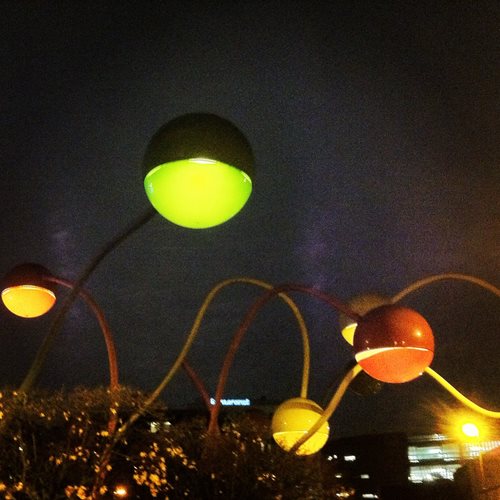
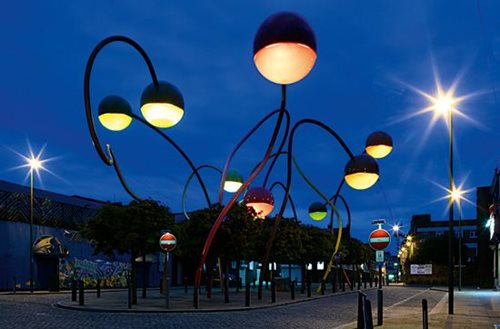
Cranhill Water Tower, Glasgow
Cranhill was an area known for crime and vandalism. The local water towers were regularly broken into, windows broken and in extreme circumstances, water supplies contaminated. The problems were profound and the towers became an icon of the problems suffered by the area. Resented by many, the residents would have been happy to see the water towers demolished.
Collective Architecture Ltd (formally Chris Stewart Architects), was approached to look at ways of regenerating the tower and its immediate surroundings. Community meetings were held and the design process was opened out to local people of all ages.
A sculptor joined the team and interpreted the communities ideas. The towers were painted white and broken windows were preplaced with durable glass.
Lighting trials experimented with cool shades of blue against green and red to reflect the theme of water. A launch event was held with some great PR and the transformed object became a focal point on the skyline and a catalyst for further regeneration in the area.
Garthamlock and Drumchapel Water Towers, Glasgow
The water towers are prominent landmarks on Glasgow’s skyline and were identified as assets that could symbolise the regeneration of the areas of Drumchaple, Garthamlock and Cranhill, while encouraging a sense of pride and ownership with the local residents of the areas. Collective Architecture was approached again to engage the community and design lighting interventions at these locations to enhance them as beacons on the landscape.
The designs combined the use of strong white light visible from far away, with intelligent colour programming.
Once again, this was a community-led initiative with steering groups and workshops. “The water tower has brought many benefits to the community of Drumchapel, with the most noticeable being the positive attitude that it brings to many of our residents.” Steering Group Chairperson
In addition, the B-listed Titan Crane in Clydebank has been transformed in a similar way through lighting.
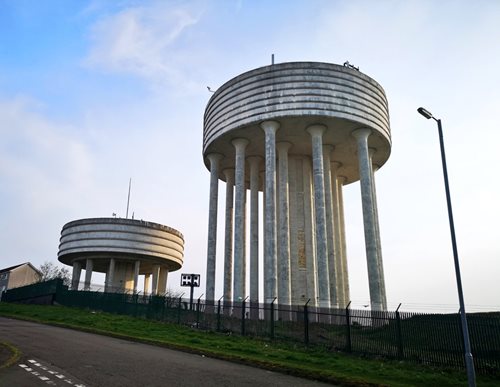
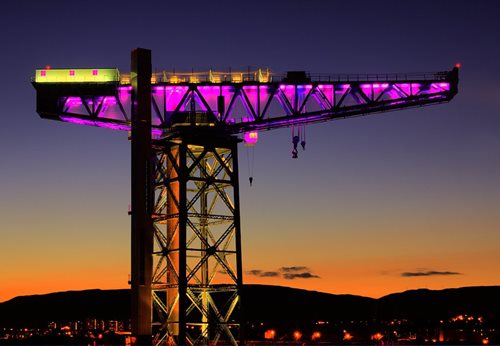
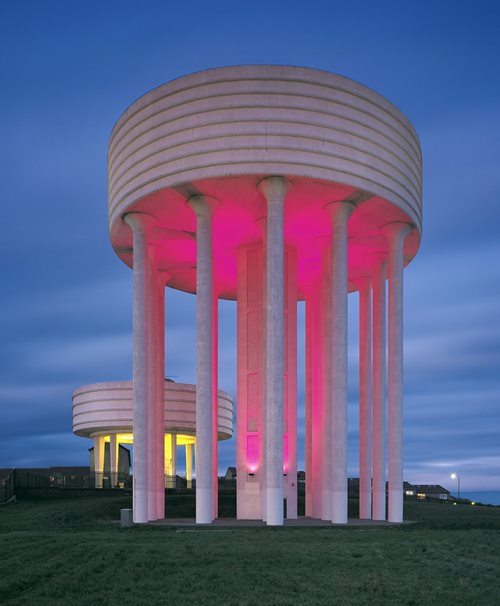
Bloomberg European Headquarters, London
This building has been the winner of numerous accolades since its completion in 2018 including Winner of the Global Lighting Design awards 2020. In 2018 it was outright winner of the RIBA Stirling Prize. From a sustainability perspective the project achieved a 98.5 per cent ‘outstanding’ rating against the BREEAM sustainability standard.
Accent lighting is located adjacent to the buildings fin design which projects from each floor, tilted towards the streetscapes below which provides a glow of soft white LED. Each optic has been selected for particular application, with the illumination from within the building providing light to the surrounding publics areas and removing the need for external light fittings and issues with glare.
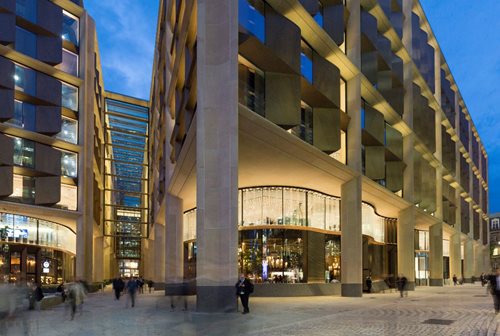
Lumiere
Derry-Londonderry
The finale to a year of celebrations as the first UK City of Culture was a light festival across public realm areas, historic buildings, squares, bridges and parkland. The displays told the story of Derry - Londonderry’s past and present against the backdrop of the city.
The Festival of Light attracted over 180,000 visitors across the city, bringing a fitting and spectacular end to a hugely successful year.
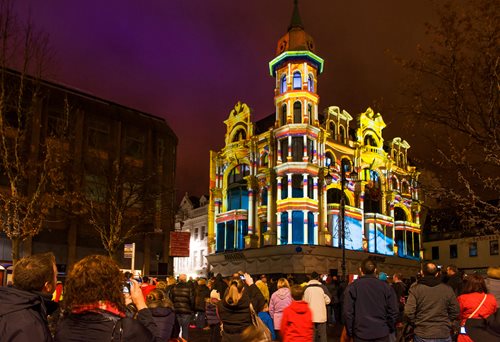
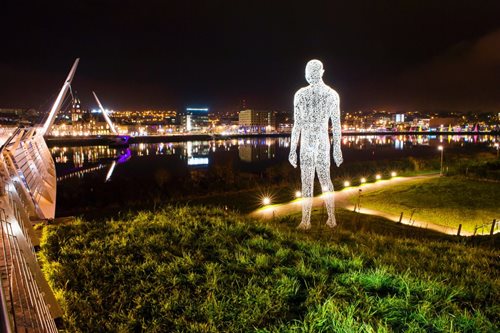
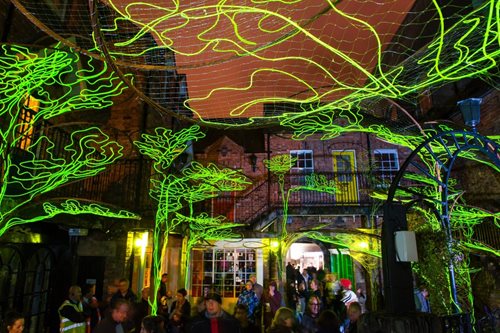
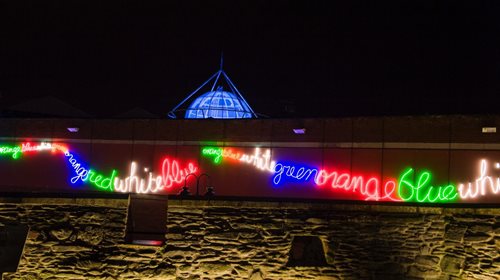
Lighting pilots projects
To inform this strategy, Belfast City Council commissioned Urban Scale Interventions to develop a series of design principles relating to lighting, and various contractors to deliver pilot projects, to trial both the principles and new approaches to the delivery of lighting in the city.
Furthermore, a series of seven design principles were created taking into account insights gathered from the workshops and engagement sessions with city stakeholders.
The co-developed design principles act as a ‘checklist’ when commissioning and delivering new lighting projects in the city, to ensure lighting is consistent whilst still responding to specific project aims. The seven principles are:
- Connecting
How might we create spaces to slow down and meet, mix and mingle? - Take notice of people and heritage
How might we create spaces where people can take notice of what is around them? - Interact and play
How might we create spaces people can have fun in? - Events and performances
How might we support live events happening in the city? - Way-finding and navigation
How might we help people navigate the city? - Safety
How might we create streets that are safe for all citizens? - Distinctly Belfast
How might we create something that speaks to the Belfast narrative?
Pilot 1 Castle Arcade
Output
The ‘river runs beneath’ neon was created as a short term solution responding to the principals outlined whilst improving the lighting throughout the arcade and adding a point of interest.
This artwork was installed as an interim measure while designs were being developed for a permanent upgrade to the entry.
Outcome
Detailed behavioural findings from the installation are difficult because of time of year, weather conditions and Covid restrictions, however anecdotal evidence suggests that whilst the installation hasn’t increased nighttime footfall through the space, it has made people think differently about the arcade. The brightness of the space has been considerably improved, which has perceived safety benefits, whilst the improvement work has helped to reduce the effect of the ‘broken windows theory’ by demonstrating that the area is cared for and has value, and lines up anticipation for the longer term entries upgrade. Spot-surveys with pedestrians passing through the arcade indicated an overall positive response with many commenting on the improved brightness in the arcade and referencing the installation narrative of the rivers underneath. If implemented on a larger scale, with more creative ‘wow-factor’ installations that are integrated into an overall theme or narrative, the hypothesis is it will dramatically improve city centre spaces and connectivity, particularly at night.
Pilot 2 Royal Avenue
Output
Belfast City Council, as part the city centre Revitalisation Programme, produced and co-ordinated a number of initiatives to animate and attract footfall in the retail core of the city during Christmas 2019. As part of this programme of activity, the council partnered with Belfast One Business Improvement District to develop a bespoke lighting mapping projection in the city centre. The animated story, written specifically for Belfast, was projected onto buildings on Royal Avenue using state-of-the-art projection and sound equipment suited to long-term outdoor use. The main feature animation was accompanied by a secondary projection across the hoardings at the Bank Building site where a large fire took place in August 2018. The animation was accompanied by a specially commissioned soundtrack orchestrated with a full brass band and choir from Belfast.
Outcome
This is the first time a projection of this scale and longevity was placed in Belfast, it was a significant success overall with over 94 per cent of surveyed audiences saying it met or exceeded their expectations. However, there were learnings from this pilot project. Most significantly the effect of ambient light in the area as well as issues with the projection site itself and health and safety issues concerning traffic on Royal Avenue. The council will encourage further largescale lighting and video-mapping projection projects. Location, ambient light, access and road safety will be key considerations in producing future projects like this.
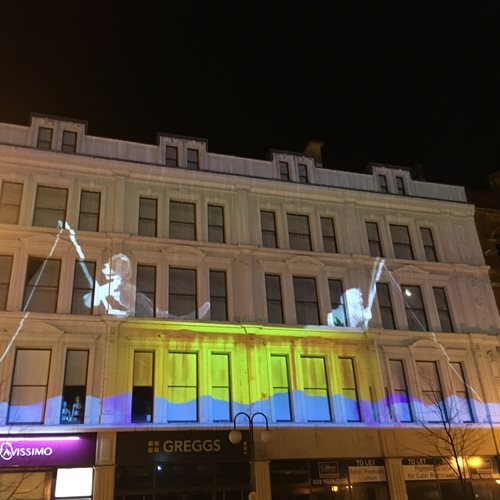
Pilot 3 Castle Street
Output
The pilot on Castle Street responded to a range of site-specific issues including anti-social behaviour, darkness, a prevalence of nonperforated shutters after 6pm and perceptions of safety and security. This pilot is made of custom innovative projection technology. The 10 projectors are installed above vacant properties and hoarding to project artist generated content onto the facades underneath. The bespoke short-throw projector units also house sound and motion sensor technology to enable interaction with pedestrians. The default content was created by a local artist/coder and referenced Belfast themes – riverways and starling murmurations, and can be easily updated for city events and festivals.
Outcome
The concept allows the street to come alive at night, with immersive audio-visual interactive content, and creates a playful ‘corridor’ for pedestrians entering and leaving the city via Castle Street, whilst also significantly brightening the street and reducing the ‘dead’ feeling created by shop shutters.
Additional feature lighting was also installed as part of a project to upgrade entries throughout the city centre. The aim of the Entries Project is to enhance permeability through creative lacemaking, reduce instances of anti-social behaviour by increasing footfall, promote connectivity, and ease navigation through the city centre. As part of the wider entries regeneration programme, Urban Scale Interventions were commissioned to deliver a series of feature lighting installations building on the lessons learnt through the design principles and pilot interventions.
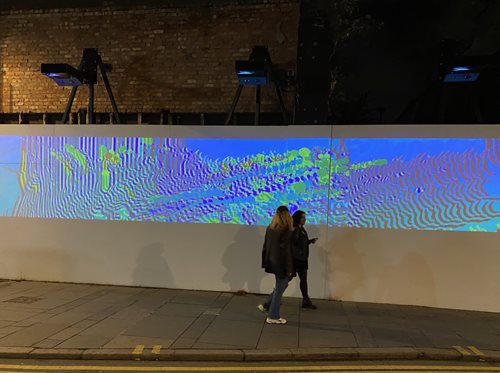
Castle Arcade
A series of suspended lighting ropes drop down to pedestrian level, the rope lights are programmable, and with a changeable spectrum of colour, flows of lights will reflect off the facades responding to a series of murals that wrap the space. An abstract soundscape inspired by the history of this entry will compliment this bespoke lighting feature. The lighting can also be programmed to change colour in response to seasonal city events and the cultural life of the city.
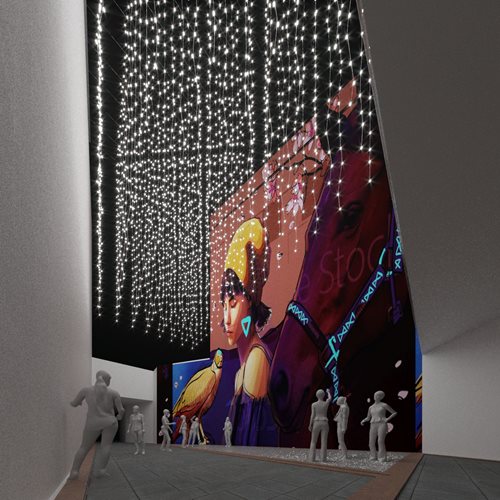
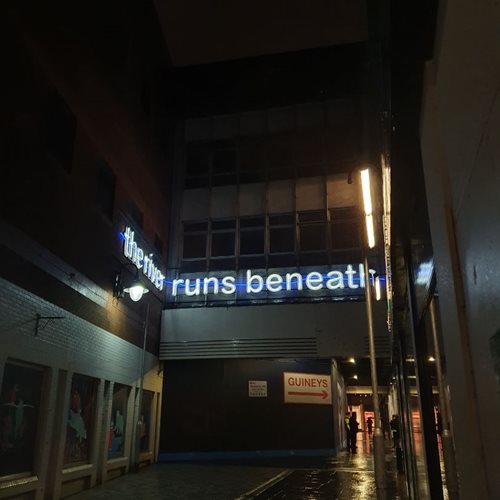
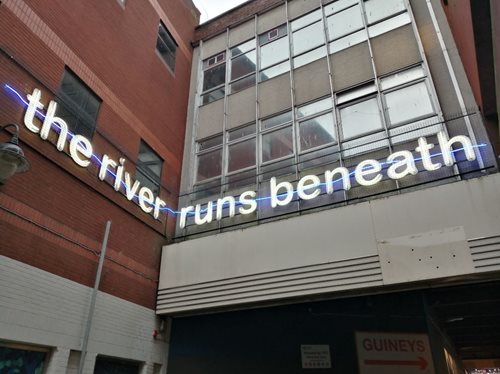
Winecellar Entry
A series of organic ocean shapes cluster above this courtyard area where people dwell outside hospitality venues. The shapes reflect the rich maritime heritage of the city and are created entirely with 3d printed recycled ocean plastics. They also change through a spectrum of colours and have speakers embedded for audio programming. This lighting feature is an opportunity to engage the city with climate change and sustainability awareness.
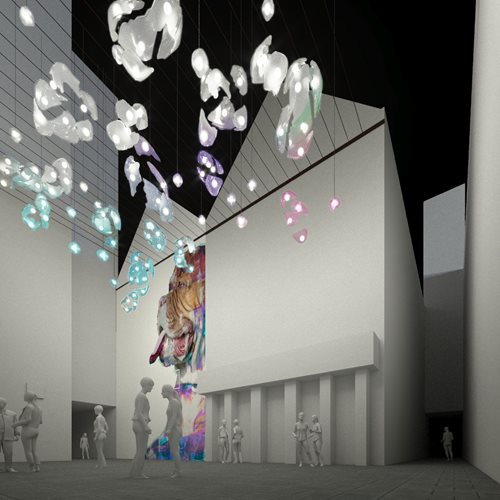
Crown Entry
A neon strip light shaped as a thunderbolt compliments a punk themed mural that identifies with Belfast’s historically rich punk music scene. The placement of the feature responds to architectural forms and functional servicing units that run along the entry. This creates a soft but conscious approach to wayfinding, drawing in passersby and giving a sense of safety, vibrance and ‘place’ to the hidden routes that connect the city streets.
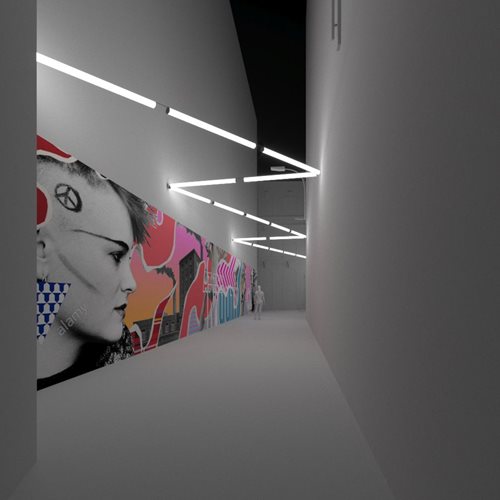
Analysis
A review of the existing lighting infrastructure within Belfast City Centre was undertaken between November 2019 and January 2020. Works involved visual inspections during day and night which allowed for review of both the aesthetics of the various fittings and the performance of the lighting itself to be observed and analysed.
Observations
Reviewed elements include: column design, wall mounted and surface mounted fittings, types of light such as SON-T, CDM -T, and LED, colour temperature and general light and design qualities.
Belfast’s buildings, road infrastructure and public spaces all form a coherent and legible city centre during the daytime, but the same cannot be said after dark. What does hold the character together during the night time experience is the well-ordered lighting infrastructure DfI manage and maintain that is threaded through the majority of the streetscape in the city centre.
Stepping out of the adopted areas managed by DfI, there are some wonderful alternative lighting schemes. For example, areas within the Cathedral Quarter have developed and grown through private/public investment and partnership arrangements. However, beyond this independent initiative and organic development, there is a need for a set of design principles to create a coherent nightime experience that combines safe routes with ways in which to celebrate the architecture and cultural heritage of Belfast.
In many cases only subtle tweaks or adjustments to the lighting is required to deliver high impact outcomes. Many of the buildings, structures or streetscapes may already have lighting infrastructure in place although it may be currently switched off or require replacement and more robust maintenance regimes to keep them in good order. Alternatively, they may not be lit due to nothing more than economic reasons.
The creation of attractive urban residential environments with a genuine sense of place is necessary to achieve our growth and sustainability targets. The quality of where we live depends not just on the design of buildings, but on their layout, landscaping and how these developments look and feel at night in terms of safety and security.
Improving the legibility of the landscape after dark, allows for the creation and development of the night time character of a city. Belfast has an opportunity to use lighting to enhance the growing number of schemes and sites under construction currently, where new builds and heritage restoration are being tied together with new and/or upgraded public realm, expanding the urban character.
In addition to the considerations, which should be addressed throughout all lighting projects, we’ve broken our site analysis and design guidance into three distinguishable urban areas – Streetscapes, Buildings and Points of Interest. This should give clarity on specific issues and solutions identified and recommended for distinct physical areas and elements of our built environment.
Streetscapes
The elements of a street, including the road, surrounding buildings, footpaths, street furniture, trees and open spaces, etc. taking in retail, office, hospitality and residential areas.
Appropriate lighting of the streetscape within each type of area has a huge impact on how we navigate and interact within it.
When LED lighting was first introduced and used within our cities and towns, the LED colour temperature was 6000k, as only at this colour temperature could enough output be viably generated.
A more ‘comfortable’ setting is used today as the performance of the LED has improved but is still further up the lighting spectrum towards blue than the lamp types previously used (SOX and Son-T).
Currently the preferred DfI settings for colour temperature is 4000k. This is based on the fact that previously, the higher the colour temperature (6000k) the more efficient the LED was.
However, modern LEDs are able to achieve the same, if not better, output at much lower colour temperatures, which in effect means lower energy consumption and higher performance.
Generally, today, all DfI lighting schemes or private lighting schemes are designed to the standards recommended in BS5489.
The DfI requirements for lighting levels are categorised. The categories are based on a range of different criteria which includes frequency of vehicle, pedestrian and cyclist movement. An evaluation and risk assessment and levels of crime and frequency of accidents all have a bearing on which category of lighting will be placed where. These categories are noted as C1: indicates a high level of light intensity, C2: a medium level of light intensity, P2/P3: a low level of light intensity.
Further detail regarding the requirements and risk assessments involved in determining lighting classes can be found in BS 5489.
DfI have strict guidance on attachments to their columns - banners, advertising assets and city dressing fixed to street lighting columns are not normally permitted, unless the design and fabrication of the column has the required structural integrity. DfI do not permit third parties to connect into their power sources without prior written agreement.
Streetscape lighting is predominantly satisfactory throughout the city centre, the majority of sites are now fitted with LED fittings, with a few residential areas operating the softer SON-T type lighting. Concerns were identified regarding the location of lighting columns rather than the level or type of light itself, and in several areas, alternative arrangements could be developed to replace the existing columns with either wall mounted fittings or by expanding the catenary lighting which is operational within some of the streetscape of Cathedral Quarter, for example.
In addition, DfC have installed high quality feature lighting on their public squares, for example the Eagle Columns on Bank Square and the Hecklers on Custom House Square.
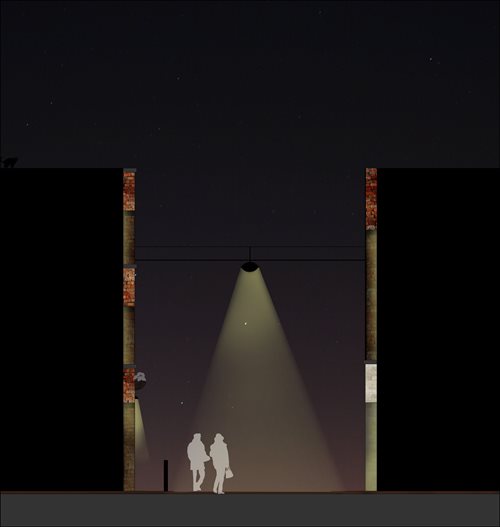
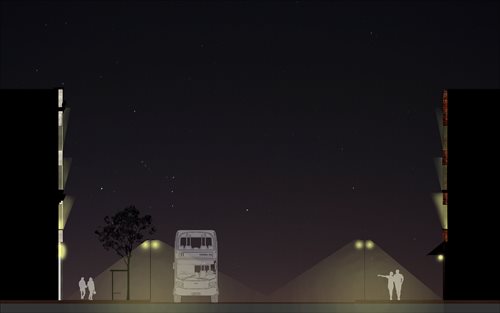
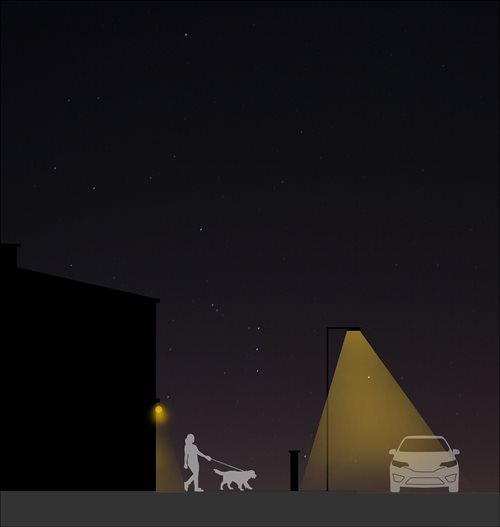
Fittings/Fixtures
There are a number of different fittings forming the current inventory of lighting types. Although not exhaustive, the range of lighting fittings include mock heritage style lamps, contemporary column mounted, ground level and building mounted fittings.
The fittings also vary in technology and therefore, colour temperature, aesthetics, replacement types and cycles for replacement. Some buildings were found to have different levels of white light which did not highlight the architectural merit and/or character of the building to its full potential.
Key routes through and around the city centre can be identified based on the mounting heights of street lighting columns. Typically, the lighting hierarchy is defined by the volume of traffic flow and the width of the streetscape.
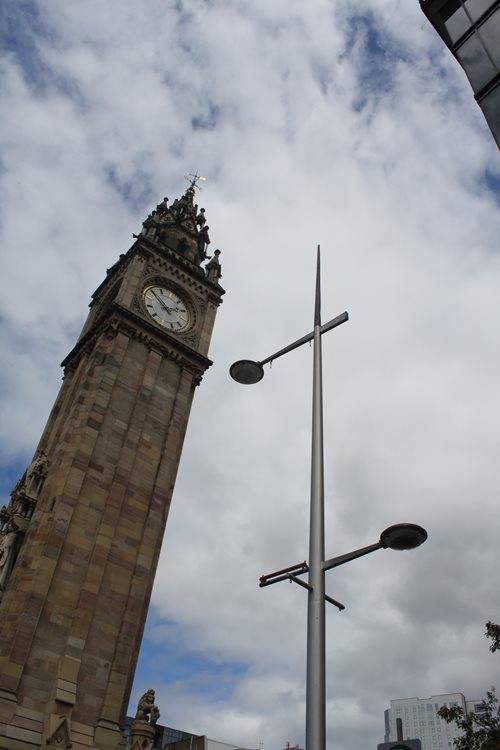
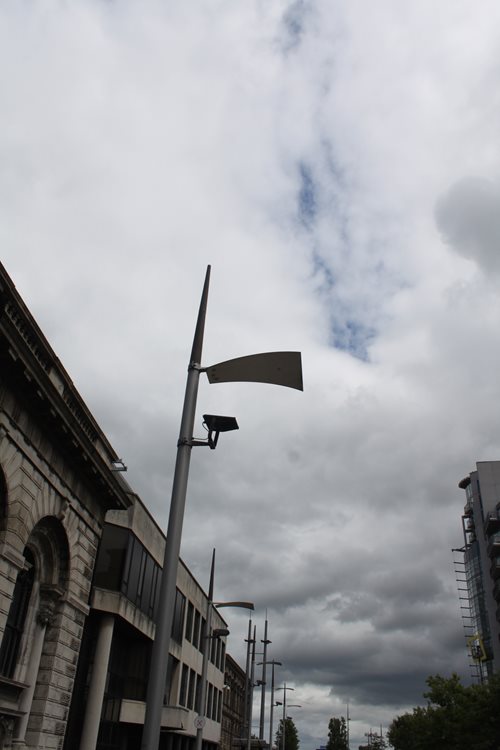
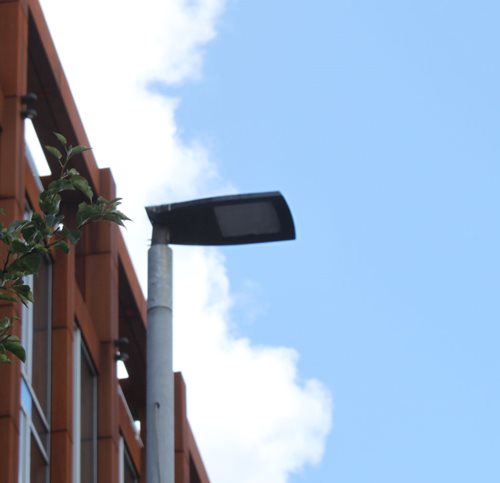
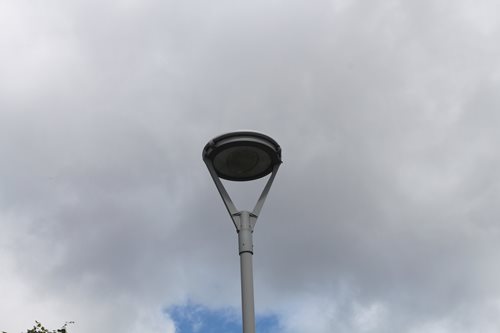
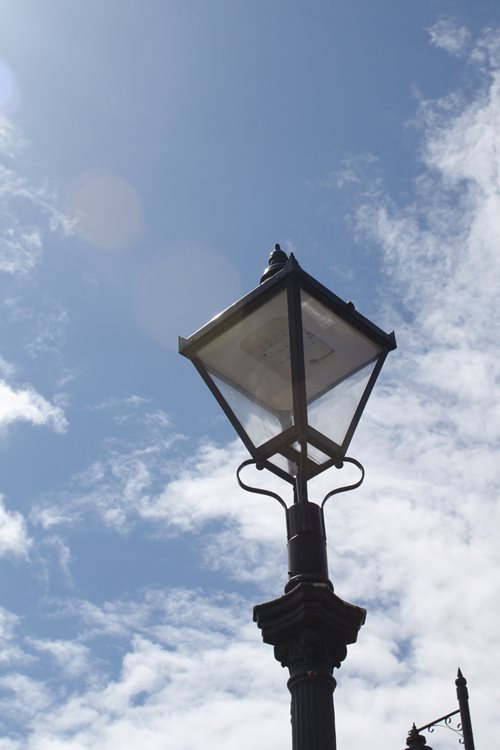
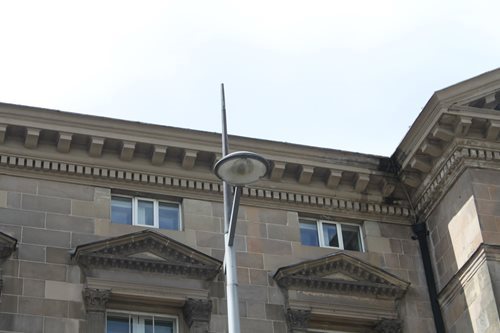
Levels of Illumination
Several areas within the city centre appear to have high levels of illumination. This could be the result of a number of factors including the introduction of third-party lighting to adjacent buildings aimed at enhancing the building facades.
In some cases, the finish of light colour, tone or reflective cladding of the unit itself can also increase the lighting intensity and consequent glare, which is exacerbated when the surrounding surfacing is a light colour, and often emphasised further during rainfall.
In terms of unpleasant ‘light spill’, advertising screens and shop fronts were evident and play a major role in the dynamically lit streetscape. Many signs, media screens and advertising sites were also visually distracting and competing with the ambient lighting. Areas of dynamic lighting effects include Shaftsbury Square and the digital advertising hoarding along Bruce Street.
Refer to the guidance note from the Institute of Lighting Professionals ‘Guidance Note 01/20’.

Buildings
Edifices large and small that make up our urban environment. Lighting buildings appropriately can have a huge positive impact our city and how we live, work and play in it.
Ongoing development across the city centre is providing opportunities for enhancement to the built environment through high performance sustainable projects. Several developments have installed lighting schemes to their frontages which complement the existing streetscape lighting and ensure the two different sets of lighting do not conflict with each other.
Belfast has a high number of buildings with cultural and heritage value. Many of these buildings are instantly recognisable landmarks and allow for subtle wayfinding through the city centre. It is evident that a number of these buildings have more value to offer to the evening and night time experience and with some sensitive lighting schemes could dramatically enhance the city’s skyline.
One such building which has embraced lighting design is the City Hall. City Hall provides an instantly recognisable setting and beacon of civic pride and stability for the city and its visitors. Adjacent to City Hall around Donegall Square are several historic buildings which would benefit from enhanced lighting to showcase their architectural features and compliment City Hall and its setting as a civic and cultural centre.
In relation to Belfast’s heritage, historic buildings and landmark features, we take reference from Historic Environment Division’s design principles.
Belfast City Library
Belfast Central Library is an example of a beautiful heritage building which, with some rearrangement of the current external lighting could show off its features to more effect and have much more impact
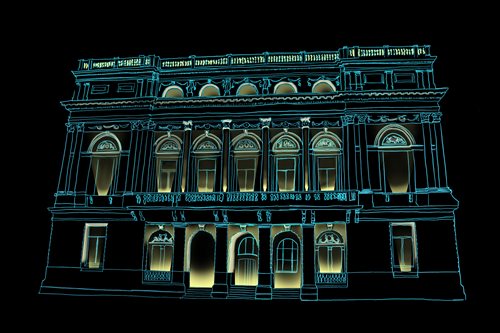
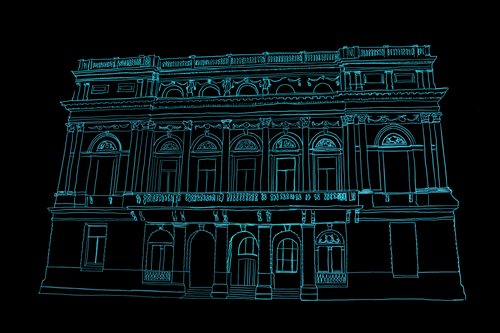
Ocean Buildings
Ocean Buildings is an example of a beautiful building which isn’t lit at night. Some subtle lighting would highlight its façade and features and add value to this architectural asset in the city centre.
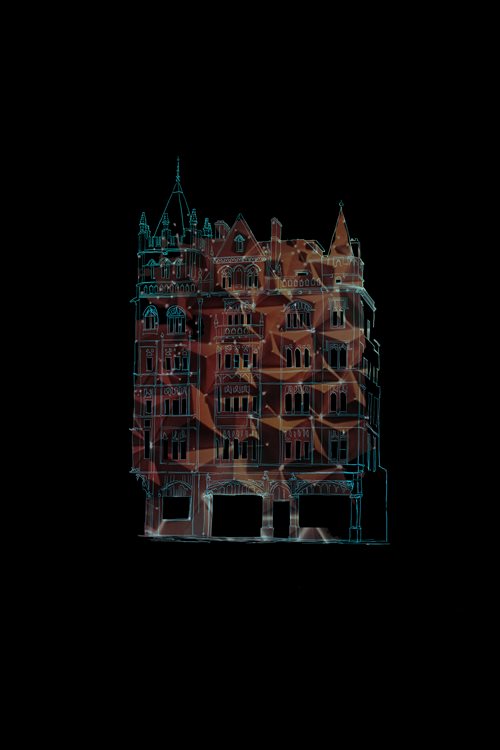
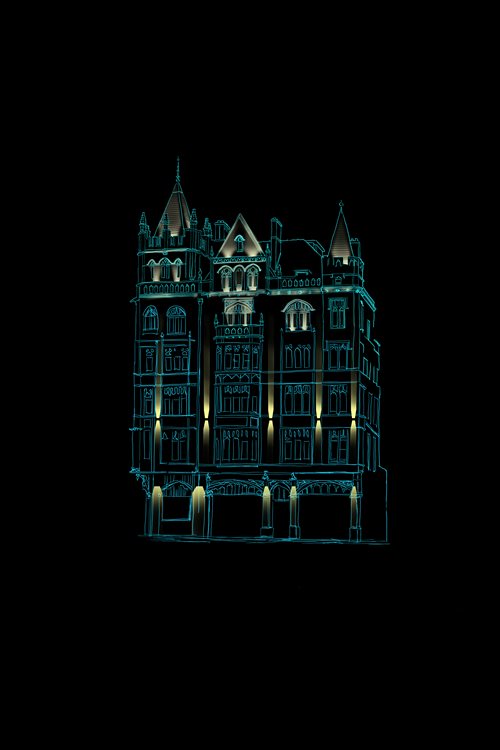
Points of Interest
Various spaces, places, objects and details that can be picked out of the urban landscape and lit to enhance character, encourage better connectivity and define an iconic skyline. Sensible and strategic lighting of these assets can address the legibility and permeability of our city and support orientation, navigation, and wayfinding.
Key Gateways
City gateways have an important role in defining arrival points to a city. They are gateway markers or landmark features that allow us to orientate ourselves and create a sense of anticipation as we approach a destination.
Belfast has its challenges in this respect due to a number of natural and infrastructural barriers around the city, but there are also opportunities to be explored.
Whilst the boundaries of the River Lagan, railway line to the south and arterial roads of the Westlink and M3 respectively define a compact and identifiable city centre. They can also be perceived as adding to the separation of some of the surrounding communities by restricting the city centre from expanding organically.
All major arterial routes in and out of the city centre are in need of lighting enhancement to increase visibility and define permeability.
However, the routes located to the west of the city namely along Grosvenor Road, Divis Street and Clifton Street are in need of particular focused consideration to create balance across the various approaches to the city.
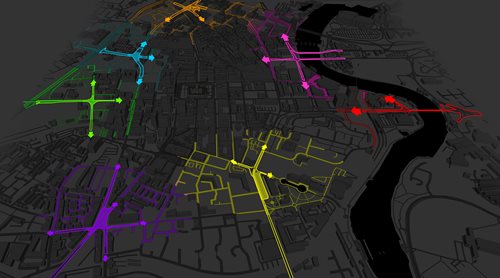
Narrative Trail
An example of a Hallowe’en themed projection installation to create a narrative trail throughout the city. Temporary projects like these can be used to guide and generate footfall to certain areas of the city and can work as part of a wider festive celebration.
Landmarks
Cities are most often identified through their skyline and a skyline is most often made up of iconic landmarks. Buildings, architectural features, physical infrastructure and public art can help orientation and navigation as well as being great locations to try some creative visual effects through the use of light.
Selective highlighting of buildings on corners or those that stop views can help reinforce existing vistas and promote visual interest and intrigue whilst promoting and stimulating pedestrian movement.
Notable Belfast landmarks and their type of lighting include, City Hall (LED), Waterfront Hall (LED), Victoria Square’s Dome (LED), Custom House (LED), St Patrick’s Church (Halogen and LED), the
Obel (LED), the Grand Central hotel (LED) the Titanic Building (LED), the lit masts along Donegall Place and the several bridges, which are lit with LED, halogen and CDM -T arrangements. Although the list is not exhaustive, it could develop further through a coordinated design approach to define a bold recognisable skyline for Belfast.
Other sites for consideration are unique destinations just outside the centre, e.g. the Crumlin Road Gaol, the Gaeltacht Quarter, Queen’s University and the Botanic Gardens, Titanic Belfast, and Ormeau Park – addressing how these locations at the periphery of the city centre influence travel and experience encountered beyond the city’s central district is key.
Public Art and Heritage Features
Several significant sculptures within the city have lighting incorporated to highlight their form, however, a review of existing arrangements should be considered with a view to improvements.
The Jaffe Memorial Fountain is lit well and is a fine example of how public art and heritage features can be sensitively treated.
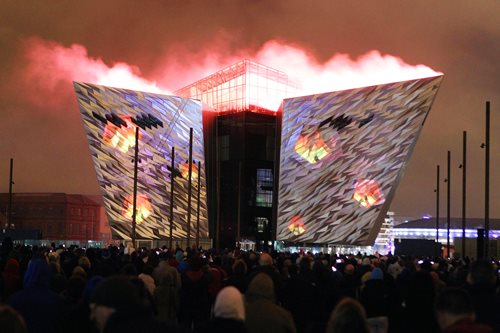
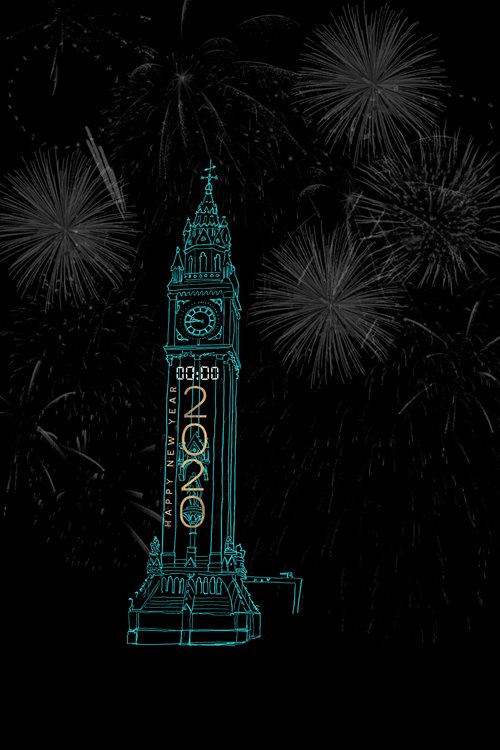
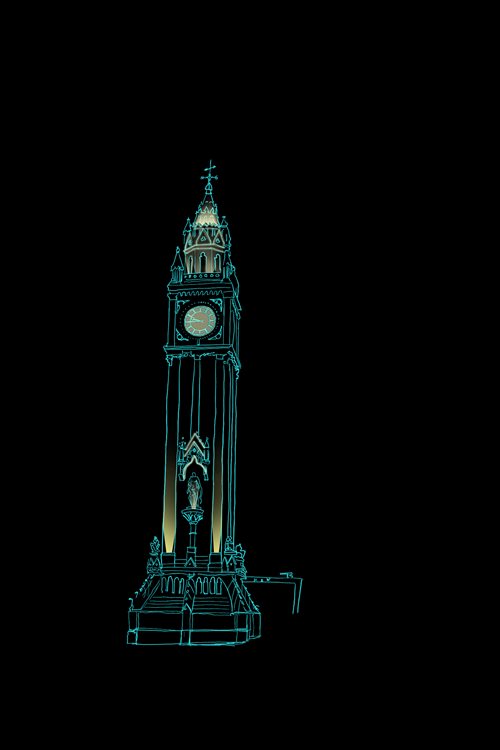
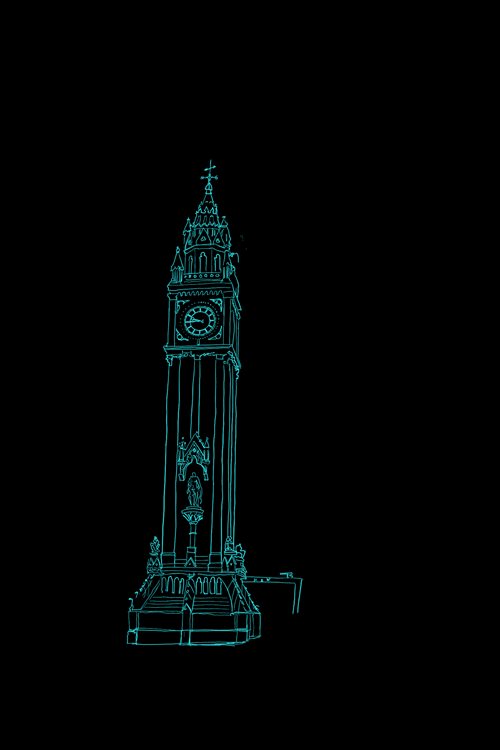
Entries and Lanes
Belfast’s entries have wonderful character that should be enhanced and expanded, however, it is very easy to walk by them without noticing they are there. Subtle highlighting of their thresholds may create an element of curiosity and intrigue and increase footfall and appreciation of these spaces as places. Unique feature ‘Instagramable’ lighting installed at appropriate points within these pathways can also drive footfall and maximise on these areas as ‘free’ tourism assets. Such environments have a range of other complexities such as a wide variety of clutter like drainpipes and air conditioning units to play down, which can also be addressed through clever lighting.
Some entries and lanes have already benefitted from years of creative development, while others are still in the early stages of creating their own individual identity. All are developing with public and private investment and to date this approach has been working well.
In addition, Linen Quarter BID is currently working on proposals to provide creative lighting of various east-west connections in the Linen Quarter, including the highlighting of key architectural features.
Bridges
Belfast has a series of historic bridges and one significant contemporary pedestrian bridge - ‘The Lagan Footbridge’ which connects the city centre to Queen’s Quay.
Although the bridges are all lit, there is no consistency to the type of light tone used, what features on the bridges are being highlighted, or when they are lit. Each bridge has a range of significant architectural features that could be better displayed and presented at night.
With new bridges and upgrades to existing bridges planned there is opportunity to maximise on the potential of illuminating the riverway.
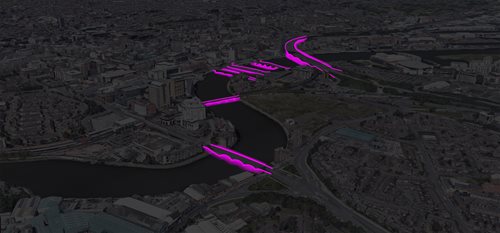
Underpasses
The underpasses of the M3 spanning the River Lagan are dimly lit and passive surveillance is limited leading to and from both the Harbour estate and on the other side of the river leading to the SSE Arena, Titanic Quarter and Scrabo Street.
With a lighting intervention these large physical barriers can become more welcoming, enhance the pedestrian experience and improve the pedestrian linkages to others areas of the city.
Pedestrian underpasses at Ann Street, and High street are regular routes for pedestrians passing under Victoria Street. The existing lighting is a mixture of LED strip lighting located into the corners of the ceiling and recessed lighting fixed into the walls of the step areas with the recent addition of a further cluster fitting of white LED lighting. The lighting currently installed does not alleviate safety concerns and there is an opportunity here to install creative lighting as a feature and transform the underpass into a more vibrant linkage and a destination in itself.
Vacant, Derelict and Construction sites
Prolonged vacant and/or ongoing construction sites can have a dramatic impact on the local environment both in the short and long term. Such sites can be perceived as unsafe, unwelcoming and can, for a period, of time have detrimental effects on an area, both economically and socially.
Sites under construction are bound by a Duty of Care obligation and through CDM Regulations NI (2016) to ensure they are secured appropriately with security hoarding. Within the city centre environment this often requires the developer to create underpass scenarios for pedestrians to access or egress under scaffolding, which can be intimidating particularly at night, as these routes are generally lit to the minimum compliance.
These interim sites often last for years at a time, severing existing pedestrian linkages from one area to another. Even with careful and considered planning of the hoarding, the public will often take alternative routes.
Considerations
When carrying out our analysis and making our recommendations we acknowledged the potential of lighting to address and deliver on current concerns and priorities for the city, as detailed in the policy context section of this document, as well building on the design principals developed and taking learnings from the pilot projects delivered. The following are a set of independent but interlinking considerations which have informed our holistic approach, recommendations and design guidance.
Connectivity
Being able to orientate and move through a city with the use of light after dark creates a safer city for all user groups. It is widely recognised that using light to reveal the hierarchy of streets, buildings and open spaces as well as their dimensions, materiality and detail, can greatly benefit a person’s experience and use of the public realm.
Belfast’s city core continues to evolve to address what has been for many years, isolation or disconnection with the surrounding areas. The expansion of an authentic city character was confined by suburban housing schemes, the Westlink and developments along the River Lagan which segregated it from the core.
The legibility of a city fundamentally improves by delivering lighting projects which define routes and pathways (both by lighting entire routes, or strategically lighting key points along a route), which in turn aids orientation and wayfinding.
This ‘linking’ or stepping stone approach to lighting both large and small routes and sites, creates the perception at least, of a more permeable city which is better connected both within its core and from its core to surrounding communities. To supplement this approach, variations in the quality of light (harsh, diffused, warm, cold) and levels of illumination can be used as tools to create texture and contrast in a city and differentiate between types of spaces and their uses.
Both large lighting schemes delivered by public authorities, and smaller independent lighting projects have a responsibility to understand and acknowledge the impact and potential of their project to contribute to reinforcing the unique character of the city, and to make it easier and more enjoyable to navigate.
Recommendations
- Any and all lighting installations should take cognisance of its potential impact on the visibility and perception of the wider landscape, and where possible and appropriate, orientate their lighting to maximise benefit.
- Ongoing regeneration and public realm work accompanying larger scale developments, should include lighting as an integral element. They should continue to extend and enhance the streetscape in the city centre and where possible expand outward into peripheral areas, to acknowledge and support them accordingly. This approach will create more cohesive linkage within the city core and the surrounding residential areas.
- Public statutory authorities should fund specific lighting projects to address issues of permeability, connectivity and accessibility.
Quality
Quality in lighting design and installation cuts across all elements. Quality of analysis, interpretation and design of the lighting, quality of the infrastructure, fittings and fixtures, and quality of the light itself. All elements must be carefully considered by the appropriate people, and the optimum decisions made based on both the objectives of the project and the wider aims and ambitions of the city.
Existing authentic character within an area can be highlighted, and new developments have the opportunity to develop or create new character which creates a sense of place through thoughtful lighting design and delivery.
Recommendations
- Commissioning the right people for each element of delivery is critical. People and organisations with a proven track record and best practice approach should be prioritised.
- Engagement and consultation are important elements. Involving the right people (public, stakeholders, end users, clients) at the right time and throughout the process in both the design and implementation of lighting is key.
- Lighting fittings can have a major impact on the appearance of a development, both during the daytime and after dark and should be carefully selected in line with the character of the site and area.
- Lighting columns and wall-mounted fittings within our streetscapes and adoptable areas should always be acceptable to the adopting authority as it will ultimately assume responsibility for maintenance and management. The fittings should be durable, resistant to damage from vandalism, easy to maintain, readily available, located both to minimise inconvenience for all, and to minimise any risk of damage to equipment by vehicles.
- Expand the range of new column design for different quarters in the city centre. This allows for subtle styling within the scheme and has worked well in defining an identity or character for areas such as those upgraded through Streets Ahead, Laganside and Titanic Quarter. This approach needs buy in from key stakeholders.
- Utilise best practice from the most up to date credible sources when deciding on the type of light appropriate for each project taking into consideration all necessary external factors. Ensure designers with expertise in lighting are at the forefront of these decisions.
Character and Culture
A city’s character and culture are intertwined, and Belfast has a wealth of both. Our identities have developed historically through the arts, sciences and other forms of human achievement which are celebrated collectively. This uniqueness is represented, manifested and celebrated through our built environment and creative activities.
We have historic and contemporary architecturally significant buildings, monuments, artworks and other important points of interest as well as numerous cultural events that bring our city’s streets and public spaces to life. All this together contributes to the cultural character of the city and helps define a sense of place.
To expand on our cultural events offer and enhance our physical assets, there are opportunities to explore how creative, sensitive and spectacular feature lighting can become an integral part of our delivery, and in turn to bolster the overall experience and increase footfall and interaction.
There is also potential to integrate innovative lighting technologies, such as curated video-mapping projection onto building facades and selected sites. Narratives positioned thoughtfully across the city as a trail would encourage movement, and pathways can be created based on other agendas such as directing people towards certain sites at certain times etc. This type of public realm ‘theatre’ can also contribute to an enhanced evening experience and night time economy.
Recommendations
- Install the CMS to allow controlled isolation, so that individual and/ or sets of lights can be controlled in response to special events, activities, celebrations and commemorations.
- Expand the range of column, fitting and fixture designs for different character areas within the city to support individuality and identity, following the lead of the former Laganside Corporation, Streets Ahead Programme and Titanic Quarter lighting columns.
- Ensure flexible and adaptable infrastructure is designed and built into public realm schemes to allow greater opportunities for events, e.g. pop-up power supplies, enclosed locations for the installation of temporary lighting or projection.
- Further review and audit needed to identify key cultural assets with a view to ensuring they are lit appropriately. Elements of the built environment identified in the ‘Points of Interest’ section of this document outline the type of features we should expect to pick out of the fabric of the city and highlight for their historical significance and/or contemporary value.
Human Centric
Studies have shown that there is a discrepancy between natural light and artificial light with regard to intensity, colour and the very nature of lighting dynamics. Natural light is dynamic in that it changes from sunrise through to nightfall, whereas artificial lighting is fixed, in a state of high intensity permanence throughout the night. Constant high intensity lighting through each night has a negative impact on our Circadian Rhythm and our well-being,
The natural intensities for light are;
- Morning- Cool light / Low intensity
- Afternoon- White light / High intensity
- Evening- Warm light / Low intensity
Recommendations
- Further research is required to establish the effects of the fixed permanent state of our street lighting.
- Introduce a wireless Central Management System (CMS) for monitoring and dimming.
Accessibility
People with disabilities, especially those with visual impairments, the senior population, and those with sensory/ neurological processing difficulties can struggle to use the city after dark.
Better consideration of the quantity, quality and uniformity of street and amenity lighting and the reduction of excessive contrast, glare and physical infrastructure itself, will help improve accessibility. Measures to use lighting to provide greater legibility after dark, such as improved lighting to signage and changes in lumen levels will also assist with orientation and ease of movement.
Recommendations
- Further research is required to understand better the impacts of lighting on people with conditions such as dementia, autism and people with learning difficulties.
- Agencies involved in the delivery of lighting schemes should, where appropriate, commit to engaging with people with lived experience of conditions such as those noted above, in terms of the design and implementation of the scheme.
- Avoid glare and high contrast.
- Design lighting on areas where level changes occur, like slopes, ramps and steps, so as to reduce shadow and ensure clear definition.
- Ensure lighting that is built into public realm is at an appropriate level or is angled/shielded to avoid sudden glare.
- Avoid any fast-moving light or repeated patterns of coloured light. If part of a special event, ensure appropriate notices are in place.
- Be aware of the effects of light on different surface types, e.g. the potential of bouncing light off mirrored or metallic surfaces and creating flashes.
Safety
Ensuring safety is a priority and key objective when it comes to lighting our city. The lighting of the main road network is an important layer as it lights both the carriageway and main footpaths, and provides appropriate light levels to highlight physical hazards where pedestrians, cyclists and motor vehicles traverse and meet.
Safety and the level of illumination should however, be appropriately balanced to ensure light levels are comfortable while being compliant. This is achievable with the use of new LED white light which can make spaces brighter without creating glare, making it possible to improve lighting and reduce illumination simultaneously. This can work particularly well in confined spaces such as entries, alongside locating and/or angling the lighting so as to avoid creating areas of shadow or darkness to avoid making pedestrians more vulnerable. Targeted lighting can also deter antisocial and criminal activity.
Recommendations
- Consider all road and street users in relation to lighting the carriageways so there is a more equal focus on cyclists and pedestrians.
- Light in relation to the topography of the area, taking into consideration changes in surface level, obstacles and light spill from surrounds.
- Provide innovative, responsive lighting control to fittings and maximize visibility and perceptions of safety for users.
- Carefully consider the positioning of lighting columns on the footpath to achieve required light levels but prevent unnecessary clutter and obstruction for all users, especially those with limited mobility, sight loss and/or push chairs. Explore wall mounting options in the first instance.
Security
Lighting plays a key role in the prevention of crime, deterring antisocial behaviour by promoting and assisting surveillance both passive and perceived. It provides the bright environment necessary for CCTV and for the PSNI to carry out their duties more safely after dark.
A reduction of contrast and glare, improvements in lighting uniformity and colour rendering, and the provision of better lighting control, all assist in enabling authorities to improve their response to incidents and safeguard against anti-social behaviour and street crime.
As the city’s population grows, lighting smaller connecting routes behind and between buildings is becoming more necessary to ensure people feel secure and confident to navigate and enjoy the city after dark. Likewise, with the increase in tourism, a sensitively, well-lit city encourages footfall and dwell time and ultimately enhances the overall atmosphere and experience of the place as a destination.
Recommendations
- Consult with relevant authorities and groups to identify conflict and vulnerable areas and take a collaborative approach to installing and managing lighting that fulfils both surveillance and placemaking needs.
- Future installations should reduce contrast and glare by use of LED.
- Focus on streets, laneways, alleys and entries surrounding residential and hotel areas in the first instance.
- Install the CMS with capacity to allow controlled isolation so that sets of lights, down to individual lights can be controlled and managed in response to incidents, changes in the area due to development, and learnings over time.
Technology
DfI are currently in the process of upgrading their street lighting to LED and from C2 class to C1. These new columns also have the capabilities of supporting a Central Management System (CMS).
There are multiple benefits to a CMS including the ability to change the light level and colour temperature throughout the night dependent on the activity or inactivity at any given time. This can be achieved by either pre-programming or by sensors which respond to movement on site. This in turn has proven to reduce energy outputs. A CMS also allows for off site monitoring, simplifying overall management.
This type of dynamic fitting and management system has been introduced across other cities’ pathways and river walks and where there are other environmental factors, concerns and ecological requirements, for e.g. disruption to existing nocturnal activity of bats and their flight corridors. An increasing number of Belfast’s DfI LED light fittings are installed with the capabilities to be linked to an intelligent management lighting control system. Reducing outputs when there is little or no activity greatly reduces energy consumption and CO2 emissions, while also protecting the wider ecology.
Recommendations
- Upgrade all public lighting in the city core to LED, incorporating a Central Management System.
- Provide infrastructure which can be dynamically responsive to incidents including movement and external light spilling into an area.
- Install creative and innovative lighting into public realm, as well as electric points for pop up temporary lighting.
- Review to consider use of renewable energies through procurement.
- The reduction of energy use and CO2 emissions is an ambition for the city, and lighting installations coming forward should be designed and approved with this in mind.
Sustainability
Sustainable lighting aims to balance the social and economic benefits of lighting with the environmental consequences, including energy use and light pollution.
Good lighting can encourage growth in a city’s resident population by providing safer, more liveable areas while acknowledging the need for dimmed, reduced light in these areas as to not affect sleep patterns. It can also contribute to a healthier more sustainable economy through providing appropriately lit retail and socialising areas, increasing social cohesion by providing safer and more pleasing environments for interaction.
Developments in technology have presented opportunities for reducing carbon emissions through both technical design and programming.
Recommendations
- The existing lighting infrastructure DfI maintain and manage has intelligent lighting management system (CMS) capability. These lighting management systems can monitor use and reduce energy outputs particularly when limited activity is evident. The same technology can also create dynamic lighting effects through the night to change from high intensity to low intensity at any given time and can monitor replacement and performance requirements. This capacity needs to be utilised.
- Reconsider quantity of lighting, and their mounting heights and positions to explore every opportunity to reduce quantity of fixtures, decrease carbon emissions and incorporate energy saving measures.
- Require, as part of the planning application process, that the applicant demonstrate clearly, measures for addressing sustainability targets and best practice with respect to lighting. Consideration should be given to the BREEAM accreditation aims when assessing these.
- Designs should be commissioned to prevent light pollution (note The Dark Skies Movement which promotes the benefits of minimising light spillage), unless it is agreed and where it is achievable and acceptable to do so, to consider light spill as a means of providing surrounding areas with ‘free’ light.
- Efforts should be made to establish the impact of light upon animal and plant life and mitigate accordingly.
- Consideration should be given to the selection of products, life cycle costs of materials and reduction of chemicals used in the manufacturing processes for lamps and columns.
- Ensure any upward lighting is directed at a surface and not into the sky.
Economic Impact
Belfast has a growing night time economy and was awarded Purple Flag status in 2019. The accreditation recognises towns and cities with well-run night-time economies. The city’s three business improvement districts, Belfast One, Destination CQ and Linen Quarter BID, all contributed to achieving this recognition.
Balancing the competing demands of economic development,public safety and quality of life is a challenge and requires the collaboration of statutory and community stakeholders with residents and local businesses.
In 2010, economists TBR valued the total night time economy across the UK at £66bn, employing 1.3 million people. The Night Time Industries Association’s (NTIA) latest reports highlight the significant economic and social contribution the night-time economy makes to the UK. According to the report, there were 1.5bn day visits to the UK in 2014, 300 million of which had a meal or night out as their focus. According to NTIA expenditure on night-time activities represented 21 per cent of the £52bn spent on day visits. In 2010 Newcastle undertook an ‘Alive after Five’ campaign and drew 7.9m additional night time visitors to the city, increasing the city’s night time economic value to £350m.
There are many examples of how the night time economy has played a vital role in revitalising cities and communities and all involve a mixed cultural and retail offering to attract a diverse demographic including both locals and visitors, late into the evening.
Recommendations
- Working with key city stakeholders, collaboratively create a clear set of objectives focusing on increasing and maximising the night time economy.
- There is evidence to suggest that the most successful ventures and night time events are those that consider families and older people. Cities should consider expanding their evening offer to target these groups.
- Invest in bespoke feature lighting installation and spectacular lighting events which draw an international audience and celebrate and showcase the city as a destination.
Planning and Delivery
Clear policy and processes in respect of the delivery and governance of lighting in the city are necessary.
The purpose of this document is to provide guidance specific to lighting, in terms of its aesthetic, environmental and amenity impact, and assist in the assessment process of proposals and applications involving lighting, where appropriate.
It is important to understand the management arrangements for lighting assets across the city to allow for quicker requests and responses to be made for creative lighting proposals, reporting of maintenance issues etc.
Recommendations
- Carry out engagement and consultations with DfI’s lighting and operations departments from the concept design stage of any scheme to understand DfI requirements.
- Improve communication and collaboration between statutory agencies and government departments to facilitate new, more efficient approaches to delivery and management of lighting going forward.
- Continue existing relationships between statutory agencies and with key city stakeholders to work together to fund, deliver and maintain innovative, creative and bespoke lighting to enhance the night time experience, for festive periods and for special events.
- Ownership, management and maintenance of statutory and non-statutory lighting/illuminations, (both standard and feature style), needs to be clearly established and agreed during the project planning process.
- Site-specific lighting strategies should be provided as part of the planning process, where appropriate.
- All new proposals involving lighting being submitted for planning consent should refer to this Luminous City, A Lighting Strategy for Belfast document for information on considerations and best practice guidance in line with the city’s placemaking agenda, and should include a ‘design and access’ statement covering such, where appropriate.
Maintenance
Maintenance of both standard functional lighting and dynamic lighting infrastructure and features in the city has historically been an issue.
Much of our streetscape and many of our public assets have had good quality functional and/or feature lighting installed as part of their development, however many assets have little to no maintenance budgets for ongoing monitoring and upkeep.
Recommendations
When public statutory authorities fund projects there is a need to determine who should own, manage and maintain them when the delivery of the project is complete. Allocating these responsibilities is critical and needs to be addressed and agreed through the budgeting and project planning process.
In line with the recommendations under Technology, the installation of a Controlled Management System (CMS) would allow for off-site monitoring, simplifying and streamlining management and reducing need for visual inspections.
Lighting design guidance
Lighting Guidance for Streetscapes
The mounting height of lighting equipment should generally be sympathetic to the height and width of a street or open area such that it either responds to the architecture or human scale.
The mounting height of fittings can have a visual impact on the streetscape in that the higher the mounting the wider spread of light, this also has an impact upon the building façade and could lead to light pollution. Mounting heights should reflect the scale of the streetscape and elements within the street, for example trees, sculptures etc.
With a city centre having a range of mounting heights it is possible to achieve differentiation of character by using lighting. This can be experienced by both vehicular and pedestrian users. Currently streets are typically lit using 10m+ high columns. This has an impact upon the streetscape with the alignment of lighting columns working with street furniture, trees and service kiosks.
The streetscapes with a lesser volume of vehicular traffic are lit via < 6m high columns or wall mounted fittings which are commonly found at this height. This approach also frees up space on the ground. Wall mounted fittings can have an impact on the placement of the light fitting on the building façade.
It is generally accepted that light fittings should, where possible, be mounted on building facades. This will greatly reduce street clutter on the footway and increase the useable areas of footpaths. Consultations and agreement on wayleaves will always be required with landowners. Consideration also needs to be given to how mounting fixtures will affect the building.
Create distinctive column design and infrastructure that contributes to the local narrative and defines an area.
Introduce subtle lighting effects into new street furniture, do not rely solely on the street lighting. This will create a rich variety of complementary lighting across the streetscape.
Depending upon their use, open spaces should be lit through minimum ambient lighting and accent lighting should be applied when creating features of interest within those spaces.
No flash lighting should be used. However, subtle colour change, whereby there is a changing colour spectrum of lighting over several seconds (managed remotely as part of wider management programme) using DMX systems can enrich spaces with this dynamic approach.
The Institute of Lighting Professionals (ILP) has provided guidance on acceptable levels of illumination for light sensitive premises in specific environmental zones, e.g. urban location, town centre, city centre.
Lighting Guidance for Buildings
- As development evolves across Belfast, developers and lighting designers should be preparing lighting strategies that complement their site context, embrace technology and maintain high quality performance.
- The building lighting should consider light quality, light level, positioning, how to reduce visual clutter/external fixtures and ways of incorporating into the material of the building if appropriate, light glare, spill and reflection in relation to surrounding materials and context.
- The building lighting should not clash with the existing adopted street lighting but provide complementary service and differentiation, using warmer white light where possible to showcase the architecture. The Bloomberg Headquarters in London is an example of how thoughtful design and installation can achieve high standards both practically and aesthetically. Rather than mounting fittings to their building, the designers used the facades to reflect lighting onto the streetscape below, complementing the street lighting.
- Each light fitting should be insignificant in appearance during the day and night.
- The lighting type should be a low energy source and output.
- Building features should be selected to pick out their key features and attributes.
- The buildings/ landmark should not be over lit to drown out the actual building feature being highlighted.
- The light type and lighting levels should be consistent across the whole façade (same level of Kelvins).
- Buildings that provide the opportunity to emphasise their depth should be promoted. Features such as inset window and building alcoves for example can create dramatic effects.
- The use of column mounted lanterns should be considered where it can be clearly demonstrated that such an arrangement makes a positive contribution to the design of the public realm or no alternative strategy is possible or practical.
Specific to: Listed, historic buildings
- There is a preference for lighting of listed building facades to be warm white light only.
- Coloured lighting on listed buildings should be restricted where feasible and only on civic occasion and authority should it be applied with prior approval in place.
- Wall mounted and surface mounted lighting should adhere to the requirements of Planning Policy Statement 6 (PPS 6): Planning, Archaeology and the Built Heritage - in terms of location, quality of materials and design.
- Light fittings should be mounted on building facades such that they respect the design and visual hierarchy of the building with site specific fixtures and brackets being considered in the case of important listed buildings or structures. Whilst spilling light onto the facades of buildings is often unavoidable lanterns should be specified so as to limit visually inappropriate scalloping or shadows.
Lighting Guidance for Points of Interest
- Each light fitting should be insignificant in appearance during the day and night.
- The lighting type should be a low energy source and output.
- Structure features should be selected to pick out their key features and attributes.
- The feature should not be over lit but lit to carefully emphasise the form and key attributes of the feature.
- The light type and lighting levels should be a consistent type across the whole façade (same level of Kelvins).
- Bridge lighting should respect the heritage fittings where possible and respectfully upgrade where feasible to do so. The undersides should have more flexibility to bring a colour change element into the design, whilst minimising the impact on local wildlife in the vicinity. The Maritime Mile (Titanic Foundation) and Back to the River (BCC) documents have additional info on the potential of illuminating bridges.
- Wall mounted and surface mounted lighting should adhere to the requirements of Planning Policy Statement 6 (PPS 6): Planning, Archaeology and the Built Heritage - in terms of location, quality of materials and design.
- Flashing lighting should be limited to specific locations and limited in most.
- Build on the success of recent pilot projects, festivals and events by creating a purposeful lighting trail around the city, linking the various quarters. This narrative could be told through lighting installations and the wonderful, dramatic effects video mapping can create.
Specific to: Entries
- To ensure creativity continues within these defined areas, the recommendation is to allow them to continue to develop through public and private initiatives. This approach will ensure each entry develops authentically, uniquely and appropriate to the users within them. Funding through arts programmes could expand this further.
- Highlighting the thresholds of the entries more uniformly or consistently would identify them as pathways and encourage exploration.
Specific to: Vacant/Development/Construction Sites
An approach that has worked well in Belfast and elsewhere is to transform these hoarding sites into temporary lighting features/ artworks. Using the hoarding as spaces for projecting or installing onto creates interest, animation and addresses the issues of the hoarding being an eyesore and a deterrent to pedestrian movement. These could be interactive and tie into seasonal activities, festivals and special events.
Through the planning stages of the development, agreements between Belfast City Council and the developer could be made regarding financing and delivery of creative, meanwhile installations which turn a potential inconvenience into a destination.
In Conclusion
Lighting has a major role to play in showcasing the character of the city by highlighting its key assets and landmarks, whilst providing safe night time routes.
To ensure the city centre achieves successful and dynamic lighting there is a requirement for strategic planning across Belfast City Council departments, Department for Communities, the Strategic Investment Board and the Department for Infrastructure, in collaboration with other stakeholders in the public, private and community sectors.
Through research and consultations, recommendations have been developed. They aim to bolster current policy and support authorities, developers, lighting designers and other key stakeholders to create cohesive, dynamic and considered lighting. The recommendations also aim to deliver on a comprehensive approach to improve lighting quality and experience across the city of Belfast.
In many cases where significant, high impact improvements across the city could be achieved, only minor or subtle changes or adjustments to the existing lighting may be required. To what degree lighting plays a part in individual projects should be based on a series of contextual considerations including the project location, surrounding context, character, scale and use. These considerations help to identify whether a bold, or more subtle intervention will work best, and whether that intervention is classic in nature, e.g. sensitively lighting the architecture of a building, or more contemporary in nature, e.g. installing bespoke, feature lighting to be provocative and fun.
As previously highlighted during the site investigations, certain buildings and structures within Belfast have lighting infrastructure in place, although it may be currently switched off or require replacement. With support, owners of such properties or features could be encouraged as to the benefits of lighting their assets thoughtfully, in line with the recommendations within this strategy.
Some areas within Belfast have significant and very distinctive character. These character areas should be celebrated and protected. Other areas are in need of creating their own language and enhancing their existing identity further. The guidance within this lighting strategy allows for flexibility of interpretation and approach, while presenting clear recommendations.
Lighting is a hugely dynamic medium whose language is easy to understand. When applied thoughtfully, lighting allows us to explore and experience the city through colour, texture, intensity, shape and shade. It can be permanent or static, fleeting or animated. It can transform, enhance, obscure, draw attention to or tell a story about an object or a place.
As we focus on developing an accessible, well connected and sustainable city which supports our social and economic ambitions, we can use lighting as a strategic tool to help create a place that people love to live, work and play in.
